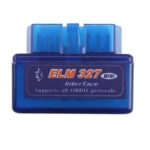This article clarifies the OBD2 requirements and exemptions for 7.3L diesel engines, specifically focusing on their compliance with California’s Smog Check program.
While most gasoline-powered vehicles from 1996 onward are required to undergo OBD2 testing as part of the Smog Check inspection, diesel vehicles follow a different set of rules. Understanding these regulations is crucial for owners of 7.3L diesel trucks.
Diesel Vehicle OBD2 Requirements in California
California’s Bureau of Automotive Repair (BAR) outlines specific OBD2 requirements for diesel vehicles. These regulations differ from those for gasoline vehicles and are based on the vehicle’s Gross Vehicle Weight Rating (GVWR).
Key Considerations for Diesel Vehicles:
- GVWR: Diesel vehicles with a GVWR over 8,500 pounds are often exempt from OBD2 testing. This is because these heavier vehicles were not originally required to meet the same OBD2 standards as lighter-duty vehicles. This exemption often applies to many 7.3L diesel trucks, particularly those in heavier-duty configurations like the Ford F-250 and F-350.
- Federal vs. California Emissions Standards: The emission standards a vehicle was originally designed to meet (federal or California) can also impact its OBD2 requirements. Federally certified diesel vehicles over 8,500 GVWR generally have no OBD2 requirements for Smog Check.
- Model Year: Even for diesel vehicles under 8,500 GVWR, the model year impacts the specific OBD2 requirements. For instance, certain readiness monitors might be allowed to be incomplete for older diesel vehicles.
7.3L Diesel Engines and Smog Check
The 7.3L Powerstroke diesel engine, commonly found in Ford trucks from 1994.5 to 2003, often falls into the exempt category due to its application in heavier-duty trucks.
Important Note: While a 7.3L diesel engine itself might not be subject to OBD2 testing, the chassis it’s installed in determines the overall Smog Check requirements. A 7.3L engine swapped into a lighter-duty vehicle originally equipped with OBD2 might still need to comply with OBD2 regulations.
Confirming Your Vehicle’s Requirements
To confirm your specific vehicle’s Smog Check requirements, refer to the following:
- Vehicle Emission Control Information (VECI) Label: Located under the hood, this label indicates the vehicle’s original certification standards (federal or California) and GVWR.
- BAR Website: The official BAR website provides resources to look up Smog Check requirements by VIN.
Smog Check Procedures for Exempt Vehicles
Diesel vehicles exempt from OBD2 testing might still require other Smog Check procedures, such as a visual inspection and a functional test of the exhaust system.
Conclusion
While many 7.3L diesel-powered vehicles are exempt from the OBD2 portion of the Smog Check due to their GVWR and certification, it’s essential to confirm your vehicle’s specific requirements using the VECI label or the BAR website. Don’t assume exemption based solely on the engine type. Understanding your vehicle’s requirements ensures a smooth Smog Check process.

